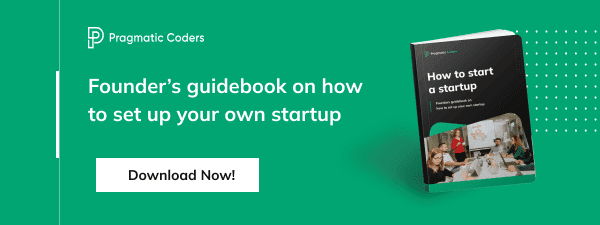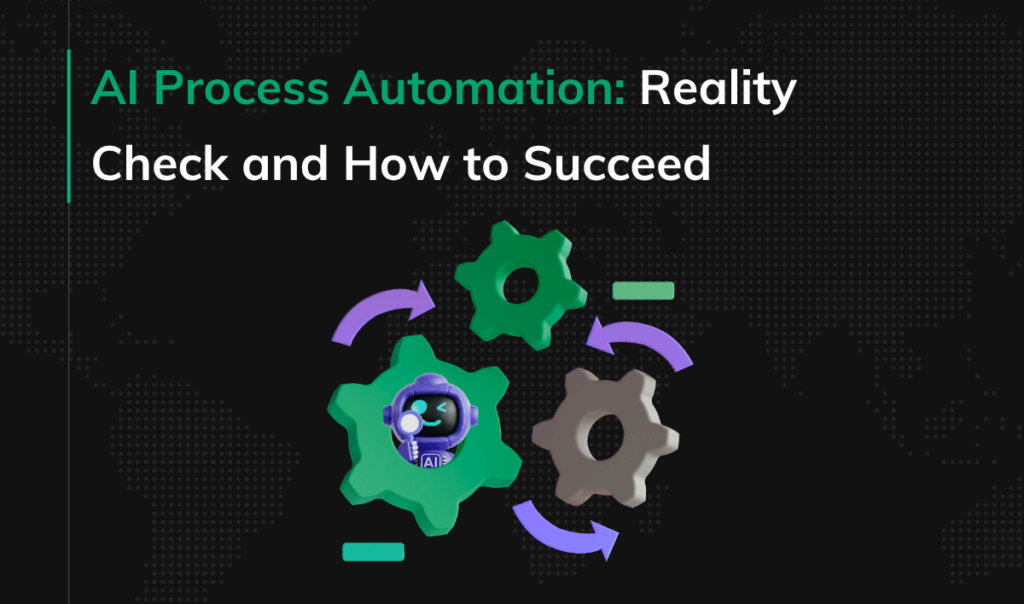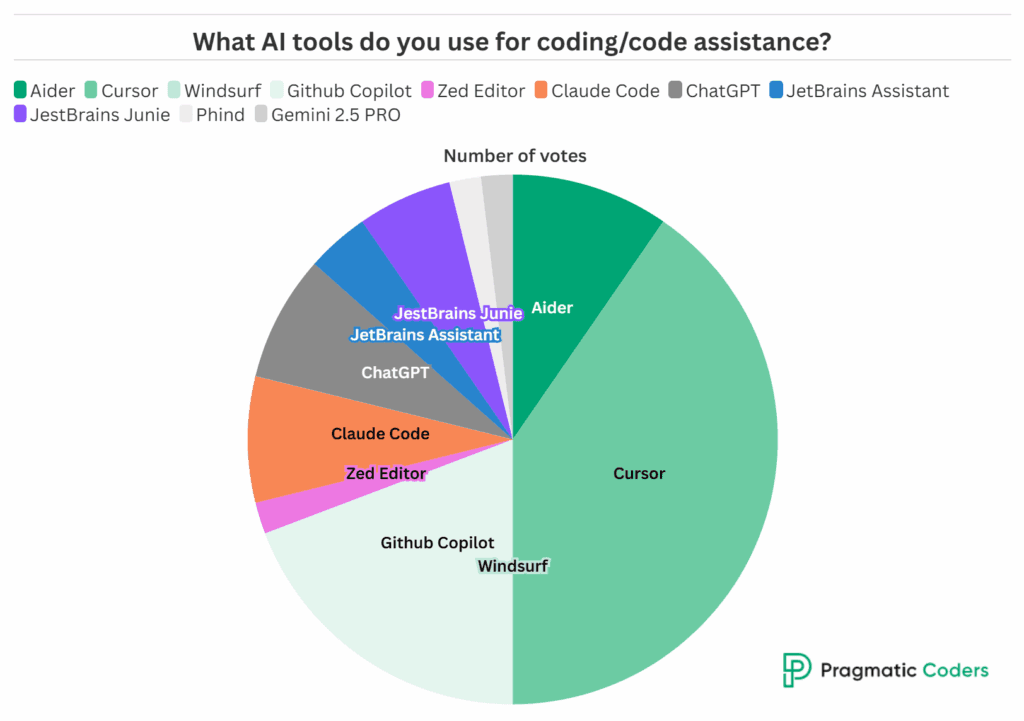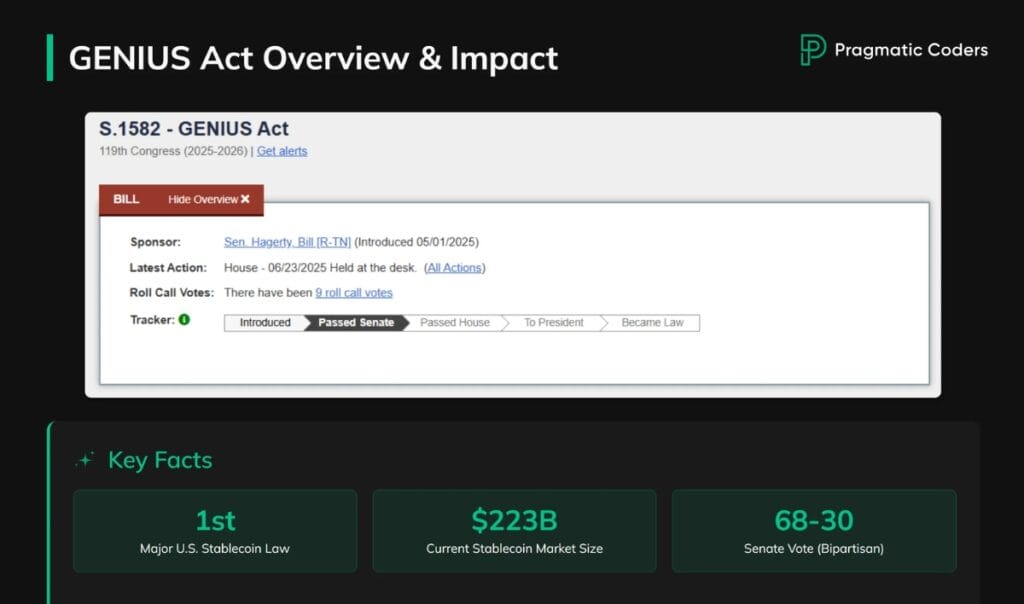How to create an MVP roadmap for my startup?

You meet with investors. You’re presenting your pitch deck, and everything goes fine. But then suddenly, a question pops up: “So what are your plans?” That’s when you take out your MVP roadmap and show them you know exactly what to do.
In this article, you’ll learn everything you need to know about creating a minimum viable product roadmap for your startup. We’ll discuss an MVP product roadmap, its benefits, and how to create one, so keep reading!
Before we start: creating an MVP roadmap is one of the last steps you need to take before starting your product development process.
But before you get there, there are many other things you need to do; competition analysis, idea validation, and creating pitch decks are just a few to mention.
To make sure you know how to build your startup RIGHT, check out our latest ebook, How to start a startup 👇
What is an MVP (minimum viable product)?
An MVP (minimum viable product) is a product’s first and most basic version with only the essential features to test if it is marketable. It allows early adopters of the product to use it and provide feedback.
What is an MVP roadmap?
An MVP roadmap is a visual representation of a startup’s short- and long-term priorities. It helps you communicate a product vision and plan the MVP development process. It serves as a product guide for all the members of your business, be it developers, the marketing team, or designers, but it is also an informative tool for your investors and other stakeholders.
Why should you build a minimum viable product?
Creating an MVP (Minimum Viable Product) roadmap can provide several benefits, including:
- Validation of business ideas & better understanding of target users
An MVP allows you to test your business idea with a small group of users before investing significant time and resources into development. All the work you’ve put into gathering information about your target audience and competitors and turning it into a product can now be tested by early adopters. They give you feedback, and you can make changes in your product when it’s still relatively easy and inexpensive to do it. And because you can check your guesses with an MVP (that is relatively cheap compared to a full product), you can minimize the risk of wasting your time and money. Only imagine how much it would cost you to change, or, what’s even worse, pivot a ready and complete product! - Improved MVP development process
A product roadmap can guide product development and help ensure that features and functionality are added logically and strategically. - Increased agility
Having a product roadmap allows you to be more agile and responsive to changes in the market, user needs, or other external factors that may impact your product. - Better resource allocation
Minimum viable product roadmaps help you prioritize features and functionality, which allows you to allocate resources more effectively. - Faster time to market
By releasing an MVP, you can get your product to market faster and begin generating revenue sooner. - Reduced risk
A product roadmap can help you identify and mitigate risks early on, which can save time, money, and resources in the long run. - More opportunities to pivot
By regularly testing your MVP and getting feedback from users, you can pivot your product more easily and effectively if necessary. - Better communication
A well-defined MVP roadmap can make communicating the product development process with stakeholders, investors, and team members much easier.
What should your MVP roadmap include?
Since an MVP roadmap is a communication tool, it’s up to you how to present the information. However, there are a few key elements your roadmap should include.
Product vision
Product vision is a long-term strategic concept that outlines the desired outcome of a startup’s product development efforts. It helps define the direction of MVP development, giving the team a sense of purpose and understanding of what they’re working towards.
Your roadmap must include your product vision because the product vision is the reason behind creating the roadmap. There would be no roadmaps without a vision, right? So treat the roadmap as a literal map leading you to your destination (the product vision).
You can use this template to verbalize your vision. Leave out the last part if you have no competition.
For [our target customer], who [customer’s need], the [product] is a [product category or description] that [unique benefits and selling points]. Unlike [competitors or current methods], our product [main differentiators].
Timeline
Timeline is a mandatory element of every minimum viable product roadmap because it lets you illustrate the order of actions you need to take to achieve your goals. Now, whether you want to add specific dates to it or not depends on your current situation. Generally, you shouldn’t commit yourself to particular dates.
In most cases, you want to focus on achieving outcomes. Concentrating on your product scope, sticking to developing features, and working against fixed deadlines might make you lose the big picture and miss the chance to maximize the business value of your product and minimize the risk of its failure.
Initiatives
Under “initiatives” we understand the more significant and extended efforts or activities undertaken to meet the success criteria.
Milestones
A milestone is a marker of progress when building your startup. It marks the achievement of an important step or event and signifies the completion of one phase and the start of another. It could be considered a “checkpoint” in the MVP development process.
Milestones indicate when a significant event or deadline should be reached and are strictly related to outcomes.
Outcomes
Before we talk about outcomes, let’s briefly summarize the difference between outcomes and outputs.
Outcomes are the things you want to achieve, the improvement. Outputs are the things that get you to achieve your desired outcomes. Outputs are your product features. In many ways, outputs help you achieve your outcomes, and that’s the essence of maximizing product value.
When creating an MVP roadmap, consider both business and product outcomes.
Business outcomes are goals you want to accomplish to generate business value or to enhance your product and make more money thanks to these enhancements.
Product outcomes are equal to the changes in your users’ behavior.
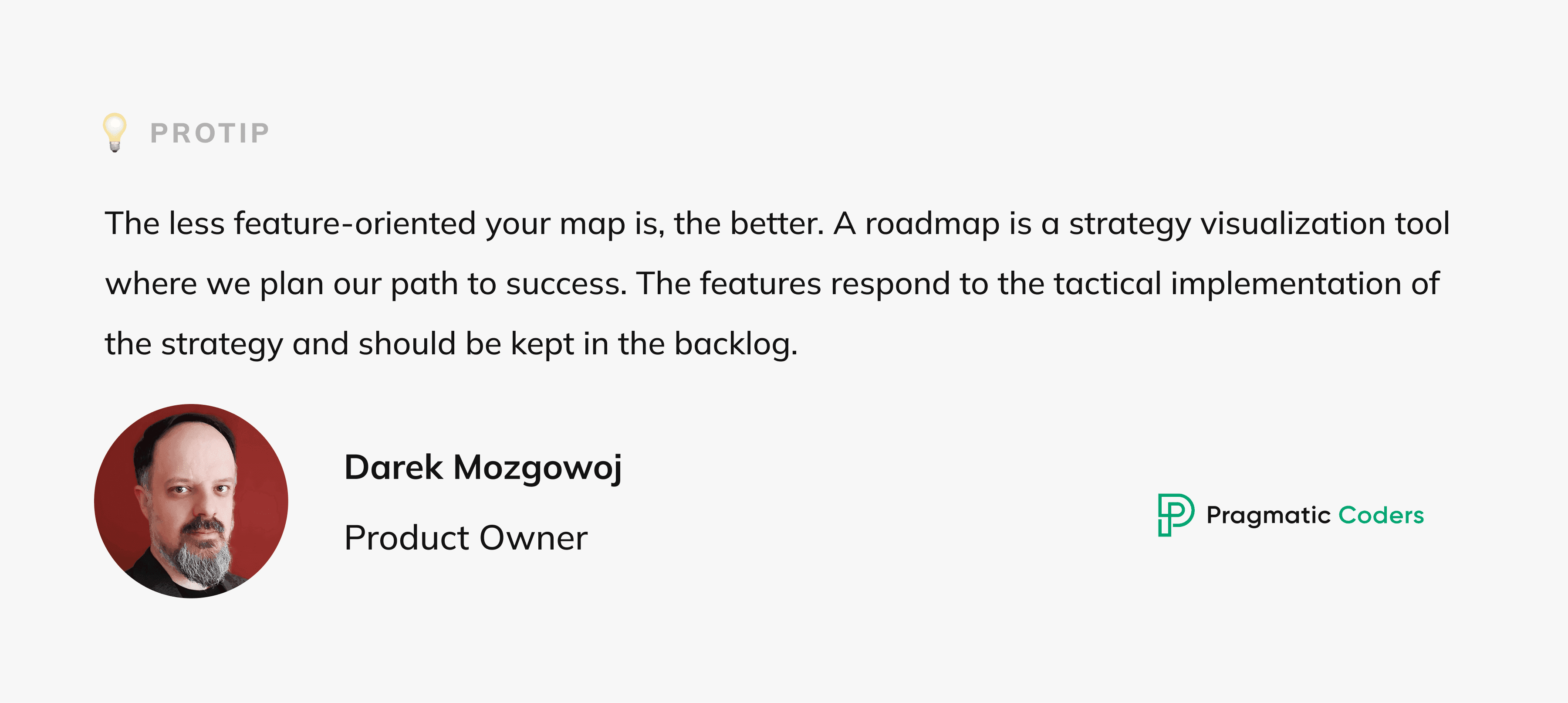
How to create an MVP roadmap in 10 steps
STEP 1. Determine your needs for the product roadmap
You need to determine why you’re creating the product map and what you want to achieve with it. This includes outlining the purpose of the roadmap, such as offering a better customer experience, increasing market share, or launching new products or features.
STEP 2. Understand the problem, your target users, and the market landscape. What business or customer needs am I trying to satisfy?
To understand the market landscape, conduct market research.
You can better assess what your users need and what problems they encounter every day by having specialists conduct UX research for you.
STEP 3. Define your MVP
Identify the core set of features that will deliver the most value to your target audience and help you validate your business idea.
STEP 4. Define your MVP success metric
Define how you will measure the success of your MVP.
STEP 5. Map out the user journey
A Pain and Gain Map is a technique used to identify customer segments, identify the pains and gains associated with them, prioritize those needs, and determine how customer expectations can be met by a product or service.
The map outlines the current customer experience versus the ideal customer experience – showing gaps that need to be addressed. It can also uncover potential innovation opportunities or new revenue streams based on unmet customer needs.
Identify user pain points and how your MVP will alleviate them. Also, identify the gains that your MVP will bring to your target audience.
STEP 6. Prioritize your features
Decide what features to build based on the level of impact they will have on your MVP’s success. Thanks to that, you’ll be able to focus on developing the core functionalities, which means minimizing development costs at the early stages of building your startup.
STEP 7. Develop an MVP development timeline
Create a realistic timeline for developing your MVP, considering your available resources.
STEP 8. Set up a testing plan
Determine how you will test your MVP with your target audience to validate your business idea and gather feedback.
STEP 9. Create a feedback loop
Incorporate user feedback from testing into your MVP roadmap to improve the final product.
STEP 10. Continuously monitor and adjust your MVP roadmap
Regularly assess the progress of your MVP development and adjust your roadmap as needed.
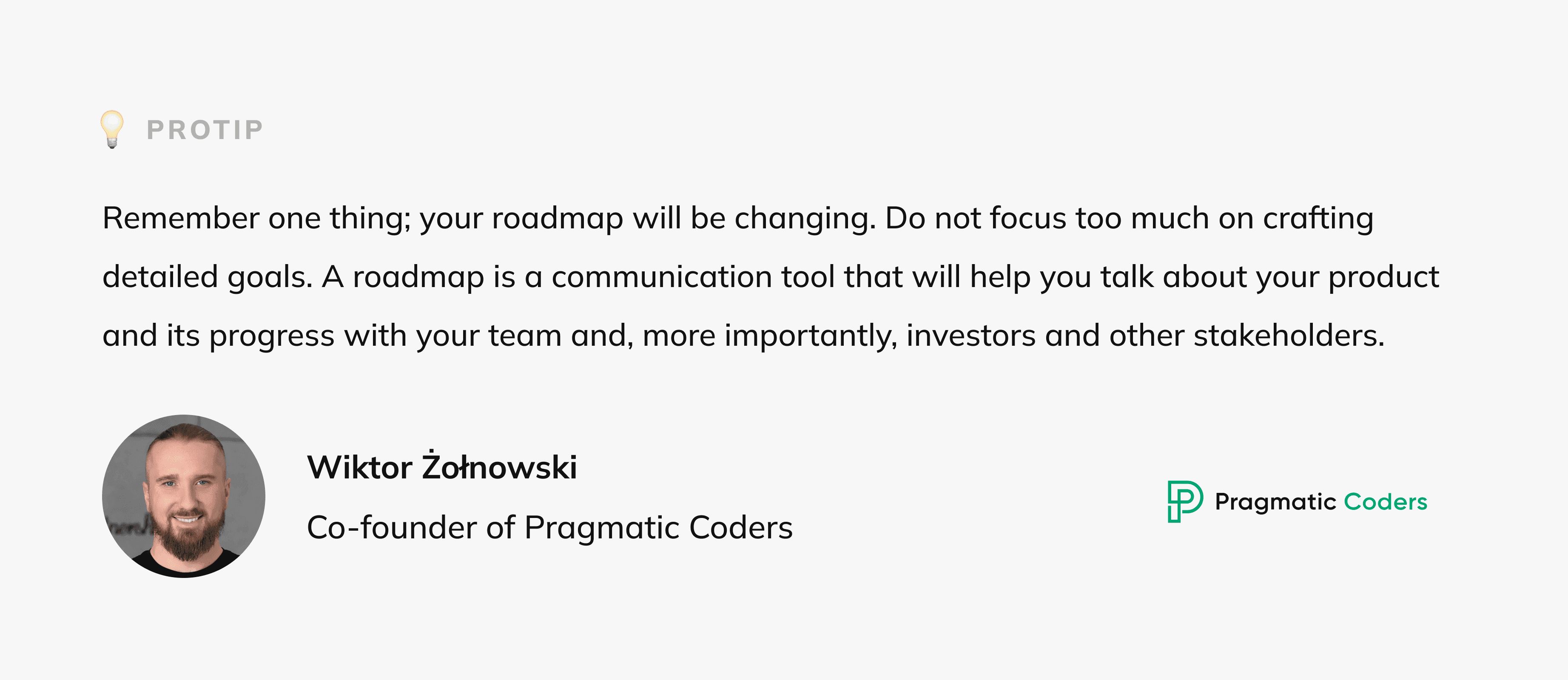
5 more thoughts on creating an MVP roadmap
Your roadmap is not all about the MVP development process
Don’t limit your MVP roadmap to the process of building a digital product. When creating a roadmap, consider things such as marketing (you need to market your prototype to encourage early adopters to test it so that they can give you feedback, based on which you can develop your product, and so on).
Concentrate on the big picture…
It depends on your situation, but if you don’t have to, you probably don’t want to use specific dates in your roadmap. The exact dates are commitments. When making such commitments to investors, you’re basically putting your head in a noose because the investors will want you to stick to those deadlines (that you came up with yourself)!
Instead, you should talk about wide timeframes (e.g., “This is going to take us 6–10 weeks.”) and focus on assigning a proper order for your and your team’s actions.
Similarly, your roadmap shouldn’t have all the tiniest details about all the features you want to develop. The general rule is the following: Don’t be specific. Instead, try to use your objectives and desired outcomes. Why? Because…
…because the details of your MVP product roadmap will change anyway
…your MVP roadmap (and your minimum viable product itself) will change significantly as creating a product roadmap is, by nature, an iterative process.
New circumstances, early-adopter feedback, sudden additional funding, and many other factors will influence your plans.
The best advice here is to be agile and adjust to the ever-changing and unstable conditions in which you’re building your product.
Focus on things that will provide immediate value with minimal effort
When planning the elements for your roadmap, think about things that can deliver the most value at where you are right now (=priorities).
Let’s imagine you want to create a dog-sitting app. The core app functionality is to connect dog owners and dog sitters. Wouldn’t it be nice if a dog sitter could attach badges and achievements to their profile? Sure it would. But is it crucial to develop such a feature early in your MVP-building process? Definitely not.
A product roadmap isn’t a product backlog.
Take Miro’s example – they admitted that around 2014, when they acquired 100k users and things got more complicated, they got caught up in trying to fix existing problems to scale.
Their roadmap looked like a backlog full of user complaints and bug reports. They were so focused on trying to fix what was wrong they forgot to think about why it was wrong. They lost the big picture and couldn’t deliver value to their customers.
How to create minimum viable product roadmaps online?
Finally, let me introduce you to three online tools to help you build MVP roadmaps quickly and easily.
- Aha! – Aha! is a web-based product roadmap tool that allows users to create visual roadmaps and timelines, track progress, and share them with stakeholders. It also includes a variety of templates and integrations with other tools like Jira and Asana.
- Trello – Trello is a simple and intuitive tool that allows users to create boards and organize tasks and ideas into lists. It can be used to create a visual product roadmap by creating boards for each stage of development and adding cards for each feature or task.
- Miro – I’ve already mentioned Miro before. It’s a digital whiteboard tool that allows for easy collaboration and organization of ideas. You can find a couple dedicated to crafting minimum viable product roadmaps among its many templates.
EXPERT INSIGHT
Yes, the map is necessary when you begin the journey into the unknown. Believe me or not, building a new product is such a journey.
Only some things on the product map are clear, but as we approach the unknown, we discover new opportunities which make the journey even more exciting.
From the process perspective, a roadmap is a fantastic tool that can open many good discussions about goals, success criteria, metrics, needs, opportunities, and many more.
However, different stakeholders can see the road map differently. At the same time, some details are unnecessary for various recipients (CEO, users, financial team, etc.). This artifact’s common parts are product vision, goals/outcomes, milestones, and business metrics, if already defined. Therefore, showing only a specific part of the road map is a good practice for common understanding.
All discussions around the roadmap have the critical aim: alignment between all stakeholders. Suppose everyone understands the roadmap the same way. In that case, the organization gains the necessary focus and ability to change the path when the situation changes.
Darek Mozgowoj
Product Owner of Pragmatic Coders
Summary
In conclusion, creating an MVP roadmap is an important step in the product development process.
By following the guidelines outlined in this article, you will be able to effectively plan and execute your MVP, validate your product idea with real customers, and gather valuable feedback to inform future development.
Remember to keep your MVP lean, focused on the most important features, and prioritize customer feedback in your next steps. With a well-crafted MVP roadmap, you will be well on your way to building a successful product that meets the needs of your target market.

